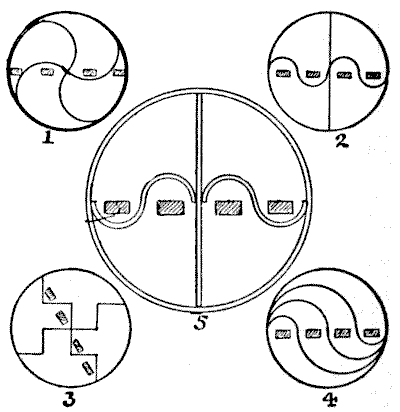
THE GARDEN WALLS.—solution
The puzzle was to divide the circular field into four equal parts by three walls, each wall being of exactly the same length. There are two essential difficulties in this problem. These are: (1) the thickness of the walls, and (2) the condition that these walls are three in number. As to the first point, since we are told that the walls are brick walls, we clearly cannot ignore their thickness, while we have to find a solution that will equally work, whether the walls be of a thickness of one, two, three, or more bricks.

The second point requires a little more consideration. How are we to distinguish between a wall and walls? A straight wall without any bend in it, no matter how long, cannot ever become "walls," if it is neither broken nor intersected in any way. Also our circular field is clearly enclosed by one wall. But if it had happened to be a square or a triangular enclosure, would there be respectively four and three walls or only one enclosing wall in each case? It is true that we speak of "the four walls" of a square building or garden, but this is only a conventional way of saying "the four sides." If you were speaking of the actual brickwork, you would say, "I am going to enclose this square garden with a wall." Angles clearly do not affect the question, for we may have a zigzag wall just as well as a straight one, and the Great Wall of China is a good example of a wall with plenty of angles. Now, if you look at Diagrams 1, 2, and 3, you may be puzzled to declare whether there are in each case two or four new walls; but you cannot call them three, as required in our puzzle. The intersection either affects the question or it does not affect it.
If you tie two pieces of string firmly together, or splice them in a nautical manner, they become "one piece of string." If you simply let them lie across one another or overlap, they remain "two pieces of string." It is all a question of joining and welding. It may similarly be held that if two walls be built into one another—I might almost say, if they be made homogeneous—they become one wall, in which case Diagrams 1, 2, and 3 might each be said to show one wall or two, if it be indicated that the four ends only touch, and are not really built into, the outer circular wall.
The objection to Diagram 4 is that although it shows the three required walls (assuming the ends are not built into the outer circular wall), yet it is only absolutely correct when we assume the walls to have no thickness. A brick has thickness, and therefore the fact throws the whole method out and renders it only approximately correct.
Diagram 5 shows, perhaps, the only correct and perfectly satisfactory solution. It will be noticed that, in addition to the circular wall, there are three new walls, which touch (and so enclose) but are not built into one another. This solution may be adapted to any desired thickness of wall, and its correctness as to area and length of wall space is so obvious that it is unnecessary to explain it. I will, however, just say that the semicircular piece of ground that each tenant gives to his neighbour is exactly equal to the semicircular piece that his neighbour gives to him, while any section of wall space found in one garden is precisely repeated in all the others. Of course there is an infinite number of ways in which this solution may be correctly varied.
click here to go to my blog.
See more interesting puzzles at http://puzzles.50webs.org